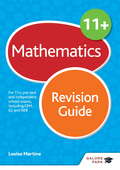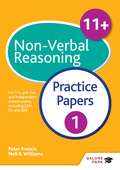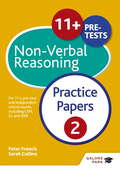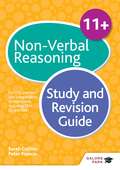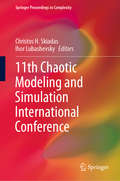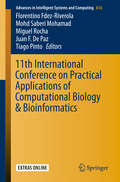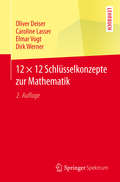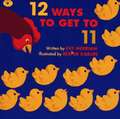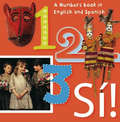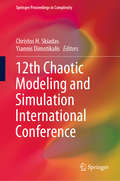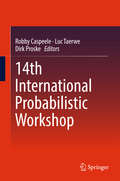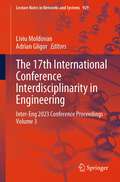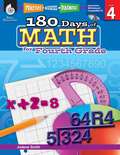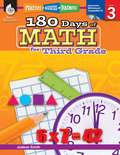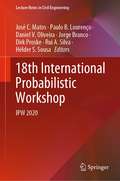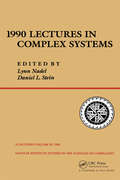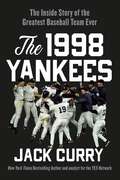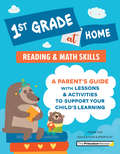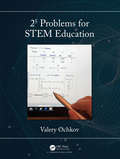- Table View
- List View
11+ Maths Revision Guide: For 11+, pre-test and independent school exams including CEM, GL and ISEB
by Louise MartineExam Board: ISEBLevel: 11 PlusSubject: MathsFirst Teaching: September 2015First Exam: Autumn 2016Secure the top marks in 11 plus independent school entrance exams and Pre-Tests leading to a better chance at getting into the school of choice with this essential revision guide. Complete coverage of the ISEB 11 Plus Maths syllabus and stretching extra content ensures that every topic is thoroughly revised ahead of the exams.This book covers everything required for the 11 Plus Maths exam- Prepares pupils for a wide range of independent school exams and pre-tests with challenging extension material- Consolidates revision with all the key information in one place- Features helpful insight in to the exams, with examples, practical tips and advice- Tests understanding and technique with timed, levelled exam-style questionsAlso available for 11 Plus Maths preparation: - 10-Minute Maths Tests Workbook Age 8-10 9781471829611- 10-Minute Maths Tests Workbook Age 9-11 9781471829635- Mental Arithmetic Workbook Age 8-10 9781471829505- Mental Arithmetic Workbook Age 9-11 9781471829628Revision Guides, Workbooks and Practice Papers are also available for English, Science, Verbal Reasoning and Non-Verbal Reasoning on www.galorepark.co.uk
11+ Non-Verbal Reasoning Practice Papers 1: For 11+, pre-test and independent school exams including CEM, GL and ISEB
by Neil R Williams Peter Francis Sarah CollinsExam Board: ISEBLevel: 11 PlusSubject: Non-Verbal ReasoningFirst Teaching: September 2016First Exam: Spring 2017Practice exam papers to prepare children for the most challenging of pre-tests and 11 plus independent school entrance exams. Includes 9 levelled exam papers that will test pupils' skills in Non-Verbal Reasoning.- Develops exam techniques tested in all major pre-tests and 11 plus independent school examinations including CEM, GL and ISEB- Features papers written to measured levels of difficulty to help build skills- Teaches pupils to improve their response rates with timed papers- Builds exam-room confidence by practicing with a variety of exam paper styles- Identifies weaker areas and improves results with detailed answers and commentaryAlso available for 11 Plus Non-Verbal Reasoning preparation: - 11 Plus Non-Verbal Reasoning Revision Guide- Non-Verbal Reasoning Workbook Age 8-10- Non-Verbal Reasoning Workbook Age 9-11- Non-Verbal Reasoning Workbook Age 10-12
11+ Non-Verbal Reasoning Practice Papers 2: For 11+, pre-test and independent school exams including CEM, GL and ISEB
by Peter Francis Sarah CollinsPrepare for the most challenging of pre-tests and 11+ independent school entrance exams with six levelled exam papers designed to test pupils' skills in Non-Verbal Reasoning exams for a better chance at getting into their school of choice. - Develops and perfects exam technique for all major pre-test and 11+ independent school exams including CEM, GL and ISEB- Features levelled papers to help build skills for the top marks - Teaches pupils to improve their response rates with timed papers- Builds exam-room confidence by practising with a variety of exam paper styles- Identifies weaker areas and improves results with detailed answers and commentaryAlso available for 11+ Non-Verbal Reasoning preparation: · 11+ Non-Verbal Reasoning Revision Guide ISBN xxx· Non-Verbal Reasoning Workbook Age 8-10 ISBN xxx· Non-Verbal Reasoning Workbook Age 9-11 ISBN xxx· Non-Verbal Reasoning Workbook Age 10-12 ISBN xx Revision Guides, Workbooks and Practice Papers are also available for Maths, English, Science and Verbal Reasoning on www.galorepark.co.uk.
11+ Non-Verbal Reasoning Study and Revision Guide: For 11+, pre-test and independent school exams including CEM, GL and ISEB
by Peter Francis Sarah CollinsExam Board: ISEBLevel: 11 PlusSubject: Non-Verbal ReasoningFirst Teaching: September 2016First Exam: Spring 2017Secure the top marks in 11 plus independent school entrance exams and pre-tests and a better chance at getting into their school of choice with this essential study and revision guide. Stretching content ensures that all the Non-Verbal Reasoning skills are thoroughly revised ahead of the exams.- Explains and tests the full range of question types and skills met in Non-Verbal Reasoning in exams- Prepares pupils for a wide range of independent school exams and pre-tests with challenging extension material- Builds on existing knowledge with clear cross-curricular links to English- Features helpful insight in to the exams, with examples, practical tips and advice- Prepares pupils for exam conditions with timed and levelled exam-style questions- Identifies strengths and weaknesses using 11 plus sample tests with detailed answer guidanceAlso available for 11 Plus Verbal Reasoning preparation: - Non-Verbal Reasoning Workbook Age 8-10 - Non-Verbal Reasoning Workbook Age 9-11 - Non Verbal Reasoning Workbook Age 10-12 - 11+ Non- Verbal Reasoning Practice Papers 1&2Revision Guides, Workbooks and Practice Papers are also available for Maths, English, Science and Verbal Reasoning on www.galorepark.co.uk
11th Chaotic Modeling and Simulation International Conference (Springer Proceedings in Complexity)
by Christos H. Skiadas Ihor LubashevskyGathering the proceedings of the 11th CHAOS2018 International Conference, this book highlights recent developments in nonlinear, dynamical and complex systems. The conference was intended to provide an essential forum for Scientists and Engineers to exchange ideas, methods, and techniques in the field of Nonlinear Dynamics, Chaos, Fractals and their applications in General Science and the Engineering Sciences. The respective chapters address key methods, empirical data and computer techniques, as well as major theoretical advances in the applied nonlinear field. Beyond showcasing the state of the art, the book will help academic and industrial researchers alike apply chaotic theory in their studies.
11th International Conference on Practical Applications of Computational Biology & Bioinformatics (Advances in Intelligent Systems and Computing #616)
by Florentino Fdez-Riverola Juan F. De Paz Mohd Saberi Mohamad Miguel Rocha Tiago PintoBiological and biomedical research are increasingly driven by experimental techniques that challenge our ability to analyse, process and extract meaningful knowledge from the underlying data. The impressive capabilities of next-generation sequencing technologies, together with novel and constantly evolving, distinct types of omics data technologies, have created an increasingly complex set of challenges for the growing fields of Bioinformatics and Computational Biology. The analysis of the datasets produced and their integration call for new algorithms and approaches from fields such as Databases, Statistics, Data Mining, Machine Learning, Optimization, Computer Science and Artificial Intelligence. Clearly, Biology is more and more a science of information and requires tools from the computational sciences. In the last few years, we have seen the rise of a new generation of interdisciplinary scientists with a strong background in the biological and computational sciences. In this context, the interaction of researchers from different scientific fields is, more than ever, of foremost importance in boosting the research efforts in the field and contributing to the education of a new generation of Bioinformatics scientists. The PACBB'17 conference was intended to contribute to this effort and promote this fruitful interaction, with a technical program that included 39 papers spanning many different sub-fields in Bioinformatics and Computational Biology. Further, the conference promoted the interaction of scientists from diverse research groups and with a distinct background (computer scientists, mathematicians, biologists).
12 × 12 Schlüsselkonzepte zur Mathematik
by Oliver Deiser Caroline Lasser Elmar Vogt Dirk WernerWie ist ein Ring definiert, wann kann man Grenzprozesse vertauschen, was sind lineare Ordnungen und wozu benötigt man das Zornsche Lemma in der Linearen Algebra? Das Buch will seinen Lesern helfen, sich in der Fülle der grundlegenden mathematischen Definitionen zurecht zu finden und exemplarische mathematische Ergebnisse einordnen und ihre Eigenheiten verstehen zu können. Es behandelt hierzu je zwölf Schlüsselkonzepte der folgenden zwölf Themengebiete der Mathematik: Grundlagen Zahlen Zahlentheorie Diskrete Mathematik Lineare Algebra Algebra Elementare Analysis Höhere Analysis Topologie und Geometrie Numerik Stochastik Mengenlehre und Logik Ein besonderes Augenmerk liegt auf einer knappen und präzisen, dabei aber nicht zu formalen Darstellung. Dadurch erlauben die einzelnen Beiträge ein fokussiertes Nachlesen ebenso wie ein neugieriges Kennenlernen. Das Buch ist geschrieben für Studierende der Mathematik ab dem ersten Semester und möchte ein treuer Begleiter und eine zuverlässige Orientierungshilfe für das gesamte Studium sein. Die 2. Auflage ist vollständig durchgesehen und um Literaturangaben ergänzt.
12 Ways to Get to 11
by Eve Merriam<p>1 2 3 4 5 6 7 8 9 10 __ 12 What happened to 11? <p>Is it in the magician's hat? Maybe it's in the mailbox or hiding in the jack-o'-lantern? Don't forget to look in the barnyard where the hen awaits the arrival of her new little chicks. Could that be where eleven went? <p>Eve Merriam and Bernie Karlin take young readers on a counting adventure as they demonstrate twelve witty and imaginative ways to get to eleven.</p>
123 Si!
by San Antonio Museum of ArtWhat better way to learn how to count than with eye-catching works of art? From fanciful folk Mexican puppets, Egyptian eyes, and lively masks to golden antiquities, Olmec era sculpture, and European paintings, children will become armchair world travelers while being introduced to the world of art and learning how to count from one to ten. This bilingual edition also introduces children at a young age to both English and Spanish.Art for this book was selected from the collection of the San Antonio Museum of Art, one of the leading art museums in the United States with a collection spanning a broad range of history and world cultures.
123 Si!
by San Antonio Museum of ArtWhat better way to learn how to count than with eye-catching works of art? From fanciful folk Mexican puppets, Egyptian eyes, and lively masks to golden antiquities, Olmec era sculpture, and European paintings, children will become armchair world travelers while being introduced to the world of art and learning how to count from one to ten. This bilingual edition also introduces children at a young age to both English and Spanish.Art for this book was selected from the collection of the San Antonio Museum of Art, one of the leading art museums in the United States with a collection spanning a broad range of history and world cultures.
12th Chaotic Modeling and Simulation International Conference (Springer Proceedings in Complexity)
by Christos H. Skiadas Yiannis DimotikalisGathering the proceedings of the 12th CHAOS2019 International Conference, this book highlights recent developments in nonlinear, dynamical and complex systems. The conference was intended to provide an essential forum for Scientists and Engineers to exchange ideas, methods, and techniques in the field of Nonlinear Dynamics, Chaos, Fractals and their applications in General Science and the Engineering Sciences. The respective chapters address key methods, empirical data and computer techniques, as well as major theoretical advances in the applied nonlinear field. Beyond showcasing the state of the art, the book will help academic and industrial researchers alike apply chaotic theory in their studies.
13 Ways to Eat a Fly
by Sue HeavenrichThirteen flies become tasty snacks in this clever reverse counting book about subtraction, predators, and prey.Science meets subtraction in this fresh and funny STEM picture book with plenty of ewww factor to please young readers. A swarm of thirteen flies buzzes along, losing one member to each predator along the way. Whether the unfortunate insects are zapped or wrapped, liquefied or zombified, the science is real--and hilariously gross. Includes a guide to eating bugs, complete with nutritional information for a single serving of flies.
14th International Probabilistic Workshop
by Robby Caspeele, Luc Taerwe and Dirk ProskeThis book presents the proceedings of the 14th International Probabilistic Workshop that was held in Ghent, Belgium in December 2016. Probabilistic methods are currently of crucial importance for research and developments in the field of engineering, which face challenges presented by new materials and technologies and rapidly changing societal needs and values. Contemporary needs related to, for example, performance-based design, service-life design, life-cycle analysis, product optimization, assessment of existing structures and structural robustness give rise to new developments as well as accurate and practically applicable probabilistic and statistical engineering methods to support these developments. These proceedings are a valuable resource for anyone interested in contemporary developments in the field of probabilistic engineering applications.
The 17th International Conference Interdisciplinarity in Engineering: Inter-Eng 2023 Conference Proceedings - Volume 3 (Lecture Notes in Networks and Systems #929)
by Liviu Moldovan Adrian GligorThis book contains research papers that were accepted for presentation at the 17th International Conference on Interdisciplinarity in Engineering—INTER-ENG 2023, which was held on 5–6 October 2023, in the city of Târgu Mureș, Romania. The general scope of the conference “Towards transition for a more competitive European industry in a smart, safe and sustainable future” is proposing a new approach related to the development of a new generation of smart factories grounded on the manufacturing and assembly process digitalization. It is related to advance manufacturing technology, lean manufacturing, sustainable manufacturing, additive manufacturing, manufacturing tools and equipment. It is a leading international professional and scientific forum of great interest for engineers and scientists who can read in this book research works contributions and recent developments as well as current practices in advanced fields of engineering.
180 Days Of Math For Fourth Grade (Practice, Assess, Diagnose)
by Jodene SmithSupport fourth grade students with 180 daily practice activities to build their mathematical fluency and demonstrate their understanding. Each problem is tied to a specific mathematical concept to help students gain regular practice of key grade-level skills. This book features quick, diagnostic-based activities that correlate to College and Career Readiness and other state standards, and includes data-driven assessment tips. Digital resources include assessment analysis tools and PDFs of the activity sheets. With this 4th grade math workbook, students will improve their math skills in no time!
180 Days of MATH for Third Grade: Practice-Assess-Diagnose
by Jodene SmithThis book provides third-grade students with 180 daily practice activities to build their mathematical fluency. Each problem is tied to a specific mathematical concept to help students gain regular practice of key grade-level skills.
18th International Probabilistic Workshop: IPW 2020 (Lecture Notes in Civil Engineering #153)
by José C. Matos Paulo B. Lourenço Daniel V. Oliveira Jorge Branco Dirk Proske Rui A. Silva Hélder S. SousaThis volume presents the proceedings of the 18th International Probabilistic Workshop (IPW), which was held in Guimarães, Portugal in May 2021. Probabilistic methods are currently of crucial importance for research and developments in the field of engineering, which face challenges presented by new materials and technologies and rapidly changing societal needs and values. Contemporary needs related to, for example, performance-based design, service-life design, life-cycle analysis, product optimization, assessment of existing structures and structural robustness give rise to new developments as well as accurate and practically applicable probabilistic and statistical engineering methods to support these developments. These proceedings are a valuable resource for anyone interested in contemporary developments in the field of probabilistic engineering applications.
1990 Lectures In Complex Systems
by Lynn Nadel Daniel I. SteinAn excellent series presenting top lecturers from the best institute for complex systems. Topics covered include: stochastic processes; fluid flow; pattern formation; information-based complexity; motor system problems; and the nature of adaptive change.
The 1998 Yankees: The Inside Story of the Greatest Baseball Team Ever
by Jack Curry"The 1998 Yankees were a perfectly constructed team. Jack Curry does an amazing job of telling the tales of that phenomenal group." —David ConeDiscover the inside story of the Yankees' unprecedented talent with this gripping account from a reporter who was there for the team's 125 wins. The visiting clubhouse in San Diego was soggy, sweaty and sticky after the 1998 Yankees swept the Padres in four games and celebrated winning their 24th World Series title. The players raised bottles of Champagne, sprayed the bubbly on each other and reveled in a baseball season that might have been more memorable than any in history. Jack Curry was part of that unforgettable scene as a reporter, navigating around the clubhouse to ask the same, pertinent question. After winning an unprecedented 125 games and pummeling teams along the way, were these Yankees, the Yankees of Jeter, Mariano, Posada, Pettitte, Bernie, O&’Neill, Tino and so many other vital players, the best team ever? &“Right now, you would have to call them the best team ever,&” said owner George Steinbrenner. Twenty five years later, Curry revisits that season to discuss how that team was built and why the Yankees were such a talented, refreshing and successful club. This book includes new interviews with more than 25 players, coaches and executives, who revealed some behind-the-stories about the magical journey and who also discussed the depth of this historic squad. &“From the first man to the 25th man on the roster, I don&’t think there&’s a team that had more talent and a team whose players knew their roles as well as our players did,&” said pitcher David Cone. &“If you&’re using that as a barometer for the best team of all-time, then I think you can call us the best team of all-time.&” During that wondrous season, Don Zimmer, a Yankee coach and a baseball lifer who began his career with the Brooklyn Dodgers in 1954, told associates there would never be another team like the 1998 Yankees. Zimmer was right. Twenty five years later, Curry describes how and why that Yankee team could be the best ever.
1st Grade at Home: A Parent's Guide with Lessons & Activities to Support Your Child's Learning (Math & Reading Skills) (Learn at Home)
by The Princeton ReviewLearn at home with help from the education experts at The Princeton Review! 1ST GRADE AT HOME provides simple, guided lessons and activities that parents can use to help keep 1st graders on track this year.Anxious about remote learning and hybrid schooling? Worried that the unique circumstances around coronavirus and education might keep your child from getting the help they need in class this year? Want to help support your child's schooling, but not sure where to start?You're not alone! 1ST GRADE AT HOME is a parent guide to supporting your child's learning, with help you can undertake from home. It provides: · Guided help for key 1st grade reading and math topics· Skills broken into short, easy-to-accomplish lessons· Explanations for parents, plus independent question sets for kids· Fun at-home learning activities for each skill that use common household items· Parent tips, review sections, and challenge activities seeded throughout the book The perfect mix of parent guidance, practical lessons, and hands-on activities to keep kids engaged and up-to-date, 1ST GRADE AT HOME covers key grade-appropriate topics including:· letters and sounds· compounds and contractions· early reading comprehension· numbers and place value· addition and subtraction· fact families· patterns and shapes... and more!
2⁵ Problems for STEM Education
by Valery Ochkov25 Problems for STEM Education introduces a new and emerging course for undergraduate STEM programs called Physical-Mathematical Informatics. This course corresponds with the new direction in education called STE(A)M (Science, Technology, Engineering, [Art] and Mathematics). The book focuses on undergraduate university students (and high school students), as well as the teachers of mathematics, physics, chemistry and other disciplines such as the humanities. This book is suitable for readers who have a basic understanding of mathematics and math software. Features Contains 32 interesting problems (studies) and new and unique methods of solving these physical and mathematical problems using a computer as well as new methods of teaching mathematics and physics Suitable for students in advanced high school courses and undergraduates, as well as for students studying Mathematical Education at the Master’s or PhD level One of the only books that attempts to bring together ST(E)AM techniques, computational mathematics and informatics in a single, unified format
2014 Ready Common Core Mathematics Instruction 7
by Curriculum Associates Llc.NIMAC-sourced textbook
2014 Ready Common Core, Mathematics Instruction [Grade] 1
by Curriculum Associates Llc.NIMAC-sourced textbook
2014 Ready Common Core, Mathematics Instruction [Grade] 2
by Curriculum Associates Llc.NIMAC-sourced textbook
2014 Ready Common Core, Mathematics Instruction [Grade] 3
by Curriculum Associates Llc.NIMAC-sourced textbook
